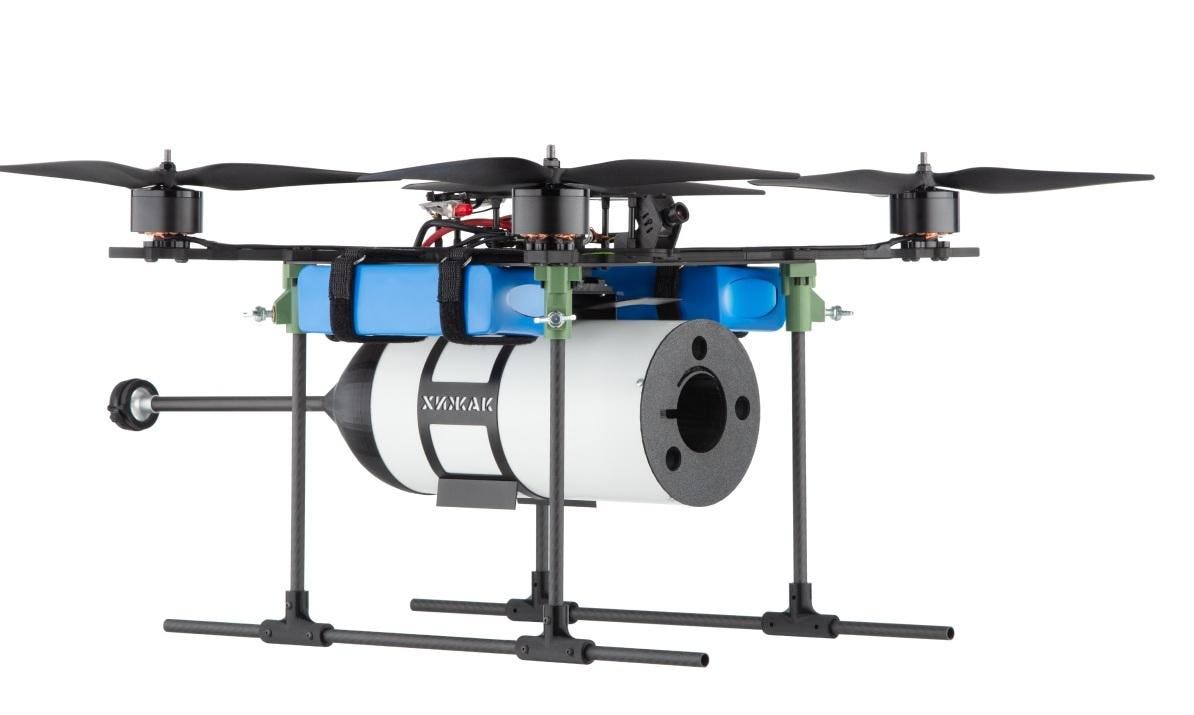The REBOFF by 3DTech is an unjammable fiber optic FPV with a range of 20 kilometers/ 12 miles
Less than eighteen months since the first prototypes appeared, drones controlled via fiber optic cable rather than radio have become a major weapon in Ukraine. Immune to jamming and able to go places where other drones cannot, fiber drones are almost impossible to stop.
I talked to Oleksiy Zhulinskiy, CEO Ukraine’s 3DTech about their work in this field, the challenges of flying fiber drones, Chinese sabotage, and the future. The Russians may have a head start in numbers, but 3DTech is ramping up production of superior designs.
“Now, our major challenge is scaling production to large volumes,” says Zhulinskiy.
Steal From The Enemy, Then Improve
The first Russian fiber FPVs appeared in early 2024. Many were skeptical whether fiber optic cables were strong enough for battlefield conditions. Ukrainian drone expert Serhii Flash thought fiber drones would likely be limited to very short ranges. But when they turned out to be effective weapons, the Ukrainians set about learning from their enemies.
“Field-captured enemy prototypes from summer 2024 inspired ours,” says Zhulinskiy.
Spool dispnesers are now more aerodynamic and reliablew
3DTech started by replacing the heavy frames used by the Russians with lightweight carbon ones. With the additional weight of the spool, every ounce matters. Improving balance was also an issue.
“Designing a fiber‑optic drone required careful weight distribution,” says Zhulinskiy. “We mount a spool with a certain length of fiber, but as it unspools and gets lighter, we must account for that in component placement.”
Initially, like the Russians, 3DTech used commercial Chinese spools. But they found they could make better ones themselves.
“The spool has evolved: aerodynamic housing to reduce drag, fiber-unspooling channel with a polished metal tip to reduce friction and static,” says Zhulinskiy.
3DTech now have their own spool-winding machines to avoid issues with spools from foreign suppliers
Making their own spools had another big advantage. Reports from the field said that some of the Chinese versions failed when the drones were launched. Worse, this may not have been accidental.
“Recently, Chinese spools often break halfway through the intended length,” says Zhulinskiy. “Possibly, though we cannot confirm this, this is deliberate sabotage from our Chinese partners.”
This concern has been echoed by other fiber drone users complaining that up to half the Chinese fiber cables snapped in flight.
To avoid such problems, 3DTech now wind their own fiber spools, with a standardized design used on different drone types which can also be retrofitted to radio-control FPVs. The company has switched to lightweight 0.25mm fiber (G657A2 ) rather than the earlier .5mm.
3DTech are constantly seeking to improve fiber quality and testing new types
“Fiber thickness doesn’t influence breakage. Our 0.25 mm fiber spools perform better than Chinese 0.5 mm ones,” says Zhulinskiy. “New fiber types are emerging, offering better flexibility and less break risk. We are testing various fibers to choose the most effective. We still rely on imports for raw fiber— but we have local winding lines and spool housing manufacturing. So our spool is almost fully localized. We’re working to diversify raw material suppliers to avoid dependency on any single country or supplier.”
3DTech upgraded other elements including the ground controller. The result, with better spools, aerodynamics and fiber might be described as a next-generation fiber drone.
Better Flying By Fiber
There are many myths about the flight limitations of fiber drones, but Zhulinskiy says that in truth pilots have had little difficulty adapting to them.
“Maneuvers like acceleration, deceleration, diving, spinning, hovering, and landing are all possible,” says Zhulinskiy. “However, pilots must carefully plan the route to avoid crossing the unspooling path, and ensure the cable isn’t severed by vehicles, infantry, or other drones.”
In some ways fiber makes piloting easier. Pilots of radio controlled FPVs have to maintain altitude because dipping below the radio horizon can cause the signal to be lost. Obstacles like trees and buildings also affect radio waves, but fiber drones can maintain a perfect signal. They can travel inside buildings and down pipes and tunnels in search of targets, or even down trenches.
“Fiber optic communication lets drones operate in environments where radio signals don’t penetrate—lowlands, enclosed spaces. On the battlefield, this has shown great effectiveness: we have many confirmed targets in closed spaces, bunkers, or areas with poor radio visibility like dense forests,” says Zhulinskiy.
Being able to go low has another big advantage.
“Flying close to the ground allows these drones to be used for ambush-style tactics, targeting logistical lines in the near and mid rear.”
There are many videos of ambush drones picking off Russian transport vehicles racing to get supplies to the front line.
“They sit in the grass and take off,” warns one Russian blogger. “So many guys die from these waiting ones. This has never happened before.”
Further And Further
Early fiber drones had ranges of 10 kilometers or less. These days many have a spool length of 20 kilometers, but 3DTech are going further.
“Designing a drone capable of long-distance missions – twenty plus kilometers — is a serious challenge. We found that not all media converters could transmit signals that far,” says Zhulinskiy. “We also need higher-quality batteries. This requires optimizing spool weight and developing efficient motor/propeller systems for energy efficiency and payload lift.”
Technology was not the only problem. The military bureaucracy had trouble dealing with this new weapon.,
“Unfortunately, the state didn’t understand how to codify them—there was no testing methodology for this kind of drone. Our efforts from autumn through winter 2025 focused on creating this methodology.”
3DTech’s specialists joined with the Ministry of Defense and other agencies to help develop testing and procedures for certifying the drones as suitable for service. And now things are moving.
“We have five NATO-codified models rated for 10–20 km range, and two more up to 30 km pending codification,” says Zhulinskiy.
And that is unlikely to be the last word. 40-kilometer fiber drones are feasible, though these are likely to be fixed-wing rather than quadcopter.
Other improvements are in the pipeline. At present 3DTech use standard low-resolution cameras, but the higher bandwidth provided by fiber means it can carry higher resolutions. This would enable the operator to spot targets at longer ranges and see finer detail – for example netting strung up to stop drones.
Ukraine’s fiber drone are already more reliable, more efficient and can hit targets at longer ranges that their Russian counterparts. Zhulinskiy estimates that around 10% of Ukrainian drones are currently fiber, a figure which is rising fast.
“Our goal is to scale up production to at least 10,000 drones per month and make the products as cheap and effective as possible, giving the military abundant, efficient tools for many missions,” says Zhulinskiy.
According to Digital Transformation Minister Mykhailo Fedorov, 15 Ukrainian manufacturers are making fiber drones, with another 20 companies producing components. This diversity allows new designs to flourish and spread. And a recent law cuts aims to help the business by cutting taxes on fiber drone components.
Russia may have introduced the world to fiber drones. But the original developer does not always have the last word and this looks like a field where Ukraine can dominate.









